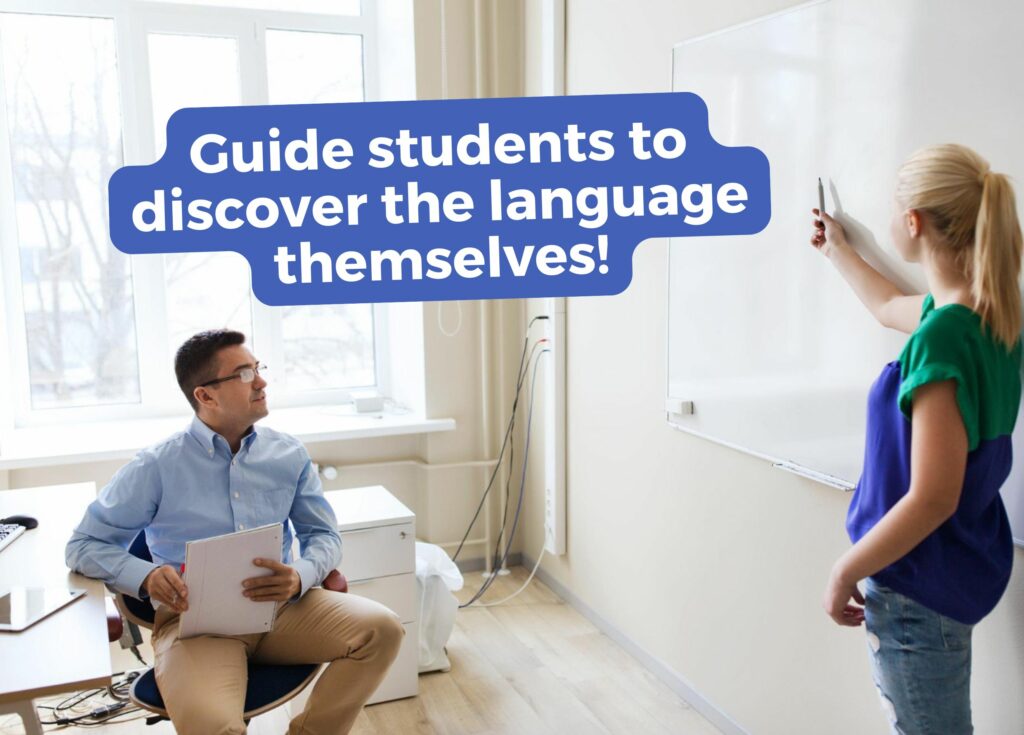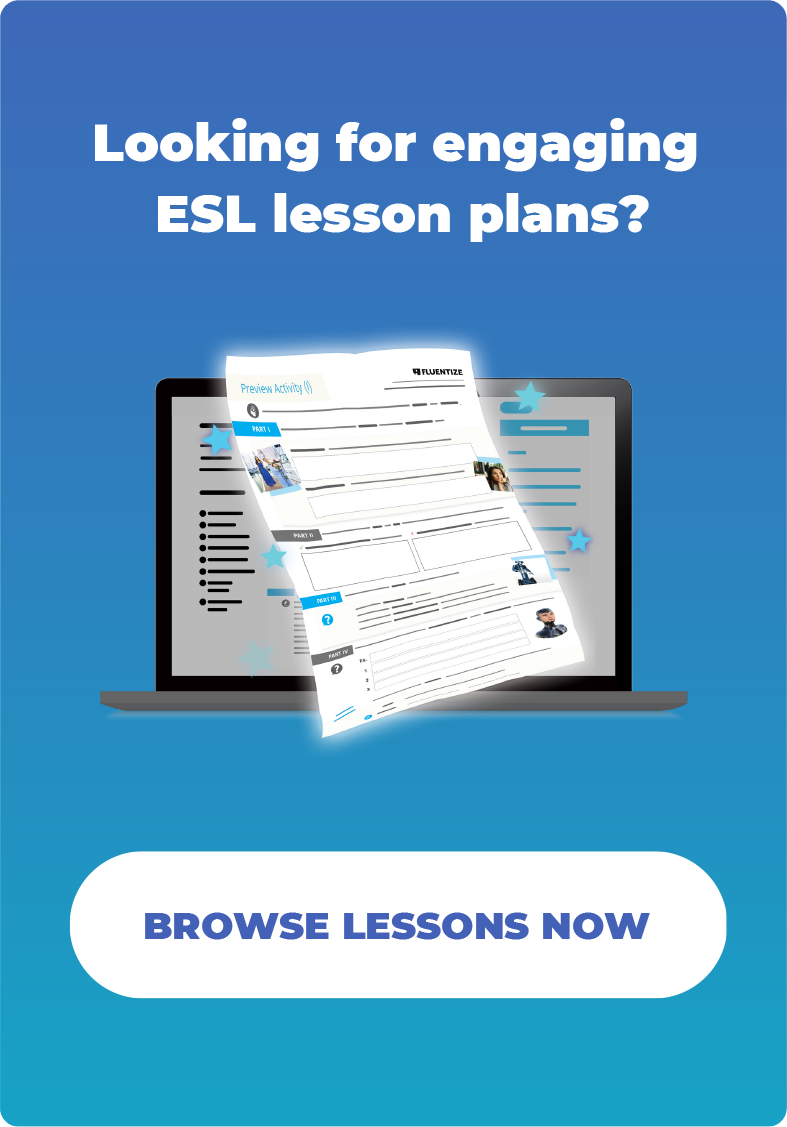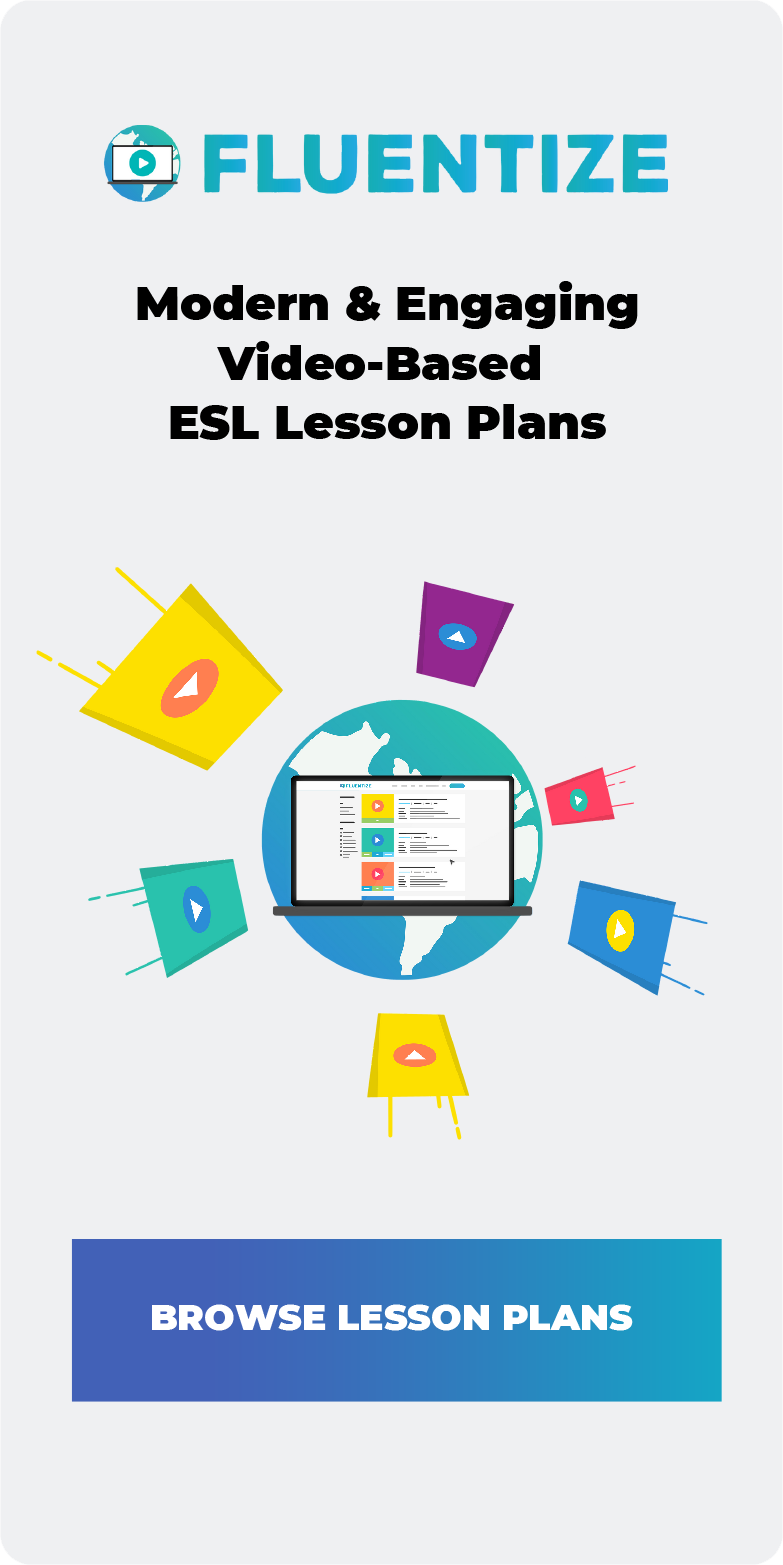The issue of using L1 in the classroom — this refers to whether or not you should communicate, or allow your students to communicate, in their L1 (language “one”, which is their native language) during class time.
Sometimes, you may hear students using L1 in the classroom. For example, they may be whispering or chatting with another student in their native language, or they may be translating sentences or ideas out loud. They may even ask you a question or try to speak with you in their native language if you also speak that language. You’ll probably experience less of this if you teach in a multilingual classroom (a class mixed with students who have different first languages), or if you don’t speak your students’ mother tongue.
This begs some questions: How to approach this? Does allowing students to use their L1 (native language) hinder them in any way throughout the learning process? Or does it actually help them? To what extent should you allow it? What rules should you make and how do you enforce them?
It’s an interesting topic to explore from an educational standpoint.
There isn’t one right approach
In my experience, there isn’t one right answer. It really depends on a few factors, including student proficiency levels, instructor methods and beliefs, school policy, and preferences. I’ve found that teachers and educators have varying opinions on it. Since I’ve spent a lot of time on both sides of the fence, as both a foreign language teacher and student, I hope to provide some insights.
Let’s check out some tips to help you navigate this issue of using L1 in the classroom. In this pot, we’ll also explore some advantages and disadvantages of:
- Allowing students to use L1 amongst each other
- Using the L1 of your students when communicating with them (if you speak your students’ native language).
Tip #1: Take advantage of body language
A practical and logical place to start is to consider or assess your students’ language level. Generally, the lower your students’ language abilities, the more open and lenient you could be when it comes to using L1 in the classroom. This is especially true when it comes to the translation of vocabulary.
However, your goal should be to try to prevent extended conversations from breaking out in your students’ L1.

Pro Tip: For lower levels, remember to speak slowly, clearly, and use body language, facial expressions, and hand gestures as much as you can. Our behaviors, actions, and body language often speak louder than the words we use. Use plenty of images and demonstrate instructions and activities. The more clearly and simply you convey your ideas, the less students will be inclined to start speaking their L1.
However, we also need to emphathize with our students. Try to view their learning experience from their perspective. Students who are learning a new language, especially as an adult, tend to filter the target language through their native tongue.
For example, if you do a vocabulary lesson and show students an image of a car, they’re going to instinctively translate the word “car” to their native language, whether it’s in their head, by saying it out loud, or writing it down and translating it.
A one-word, quick translation of the word “car” probably won’t negatively impact the lesson or their learning. It may actually be quite effective for students when learning vocabulary.
Furthermore, you can safely assume that since your student just saw an image of a car, the translation you heard them say out loud is most likely (and hopefully!) accurate. Therefore, translating words to L1 at lower levels helps with language acquisition in terms of accuracy.
You must also remember that you can’t always be sure if students are translating words properly. Sure, when translating the word “car” after seeing an image of a car, you can be confident it’s accurate. However, this can get tricky with translations for more advanced words or situations. This is why teaching vocabulary and grammar in context is so important! Instead of just teaching students “This is a car”, you could follow it up by asking students: “Do you have a car? How often do you drive a car?”, etc. This technique confirms that your students understand concepts, which leads us to CCQs and guided discovery.
Tip #2: Implement techniques like CCQ and guided discovery
Make sure L1 is only being used to facilitate the tasks, clarify complex information, or translate vocabulary. Have students use L1 as a last resort, and try to keep it to a minimum. Obviously, if you’re doing conversation lessons with teens or adults, you should avoid having conversations in L1.
When it comes to higher-level students, it should be easier to explain grammar rules in a variety of ways in English to them in comparison with lower-level students.
Another tip worth mentioning here is that you should consider avoiding explanations as much as you can when it comes to teaching vocabulary and grammar, and instead use various techniques like CCQs and guided discovery, as demonstrated by the following example.

Let’s say you’re introducing new vocabulary or grammar in a lesson. Students translate the words to their L1, which helps a lot with accuracy and understanding. But before you get to the point where you actually translate the target vocabulary, we recommended going through a process of teaching the target vocabulary or grammar through the target language. The approach can be implemented in your instruction and also found in various ready-made lesson materials.
Guided discovery is just a way of helping your students uncover vocabulary meanings and usage, or perhaps the function of a grammar point. This is often done by asking questions and giving context clues.
Here is an example below of guided discovery in action. This example is based on a lesson plan we offer on Fluentize:
- Give a context example sentence using the vocabulary word.
Some people thrive when they’re under pressure, but I often make mistakes when I am under a lot of pressure!
- Have students try to deduce the meaning by giving you their own synonym or definition. Hopefully you hear a synonym like “to succeed.”
- Ask CCQ (concept check questions) to make sure students understand it properly.
Do you usually thrive under pressure?
Do you feel like you thrive at your job?
- Give another example sentence if they still don’t understand.
My brother thrives at athletics. Last year he won the gold medals for a school competition in the 100-meter dash and high-jump.
- Give students the definition or synonym of the word/phrase in English, and have students translate it on their own (or translate it for them if you know L1).
to thrive: to be successful or perform really well in specific situations or roles
- Be creative with your context examples so that they give students enough information. We want them to deduce and comprehend the meaning and usage of the word or phrase. Take a look at the two sentence below:
I thrive at my job.
I thrive at my job because I have 10 years of experience, I love what I do, and I had great training.
Obviously, the second example will allow students to deduce the meaning of the word “thrive” better than the first one. After giving them examples in English and doing CCQ, you could actually encourage students to demonstrate their understanding of the vocabulary by defining or translating it for you in their L1.
The point here is that when you use these kinds of techniques, using L1 in the classroom won’t even be necessary.
Tip #3: Convey the value of target language communication
Some students may be shy or embarrassed to make mistakes, so they revert to using L1 in the classroom. To avoid this, we should consistently reassure, encourage, and remind students that in order to become proficient in a language, it’s beneficial to step outside their comfort zone!
If you find your students using L1 in the classroom a lot, you can mention this at the start of classes, or any other times you hear them using it. This is more of a direct way to get students to use the target language, but it can be helpful.

When students try to express themselves in the target language, it will get their mental gears working, clicking, and thinking fluently. This is crucial in language education and an important part of proficiency. Students should start to develop their flow of thoughts and ideas in the target language. In real life situations, they won’t have L1 as a lifeline all the time. This fact should be communicated to your students.
When I was learning Czech language, even though my teacher spoke English, if I had asked a question about a grammar point in English she would have told me to try asking in Czech, since some of the other students in class didn’t speak English. While it was challenging, it was valuable in terms of language development. I had to continually construct complex questions in my brain in Czech language which wasn’t easy, but it forced me to start thinking in the target language.
I remember that using English was incredibly helpful to me sometimes while learning Czech when it came to things like translation of vocabulary terms. There was another American in my class, and we helped each other a lot in our L1 during class time. However, we rarely got into full conversations in English. That’s because we knew what would have happened—the teacher would have intervened and directed us back to Czech language.
Things can get tricky when students start having side conversations during class in L1. It may be disruptive when you’re trying to instruct. Especially if you don’t know the L1 of your students, it may feel a bit uncomfortable.
Have you ever experienced other people speaking a foreign language in front of you? You may have felt like an outsider or simply wondering what they’re talking about.
As a teacher, students using L1 in the classroom can also make you feel like you’ve lost control a bit. You’re not sure what students are talking about or if they’re on topic. And even if they are on topic, you may not be sure if they’ve resolved what needs to be resolved accurately (e.g., instructions for an activity).
However, as a general rule of thumb, the more your students are using the target language in class, the better. We want to immerse students in the language and get them using it as much as possible. We want their minds to be navigating in the foreign language as much as possible.

While monitoring role plays or class activities, walk around and gently guide students back to English if they’ve slipped into their L1. It’s okay to allow brief L1 use for quick clarifications or complex instructions, but make it clear that transitioning back to English is the goal. This approach respects their need for occasional L1 support while reinforcing L2 use.
Some students may simply have discomfort about speaking English in class. In this case, you can encourage them and emphasize that making mistakes is a natural part of learning. You can also keep things engaging and integrate activities that make English the natural choice, like role-plays or simple-to-understand conversation tasks where using L2 is essential for success. If they look confused, you can approach them or try to demonstrate, give alternative examples, or explain ideas in a simpler way. Encourage them to explain any confusion in English.
Be aware of students’ communication exchanges
Another feeling of discomfort can come when you’re not sure if students are talking about the class content or not. Pay attention to clues in the exchange of communication, behavior, and facial expressions of your students during pair or group work. If students are pointing to the textbook, activity, or whiteboard while speaking L1, you could assume they’re on task. However, if students start giggling while looking at their mobile devices, you know it’s probably not related to the task. I know these are two extreme cases, but the point is that body language will give you a good idea as to whether or not L1 is being used in connection to the class content.
You should also keep in mind that excessive communication in L1 could be disruptive to other students. It may also disrupt the flow of thoughts in the target language. Thinking in the target language is an integral part of reaching fluency. If students are constantly switching to L1, their flow of thoughts is disrupted. As a result, using L1 in the classroom can become a barrier to learning.
In order to resolve this issue, it’s probably good to know why students sometimes resort to and have a tendency to use L1. The answer comes in a few parts, but it’s mostly about familiarity, comfort, accuracy, and clarification.
Tip #3: Discover why students are using L1 in the classroom
Students using L1 in a group classroom could be an indication that you didn’t instruct or explain something clearly, or that something is unclear in the class material. So, in some cases, your students using L1 in the classroom may just be an attempt to interpret instructions, clarify a concept, or make sense of a sentence, grammar point, or phrase. A good way to resolve this and get back to the target language is to politely approach the students and offer to clarify the matter at hand in a different or simpler way (in English). In essence, be proactive in clarifying tasks:

- Do you have any questions?
- Can I help you with something?
- Is everything clear?
This puts things back in your control, and gives you the chance to clarify or demonstrate a concept in a different way. It also forces students to revert back to and respond in English.
However, it can get even more complicated if you’re putting yourself in a situation to “explain” a concept, which often creates more misunderstandings. More misunderstandings could lead to more L1 use among students as they try to comprehend your explanation. For intermediate or higher-level students, finding new or different ways to explain a sentence, phrase, grammar point, etc. may be very effective, but for lower levels, you’ll have to be a bit more creative.
Remember that it may not be a bad thing if students’ use of L1 is related to class and the task at hand. As long as side conversations don’t develop, dominate, and disrupt the flow of the lesson, it may not be problematic. If a student asks another student for help about task instructions in L1, it can actually be helpful and speed things up a bit during the lesson. It may even relieve your duty of trying to explain activity instructions in a simpler way, since there may not be a simpler way to explain it to a lower-level student. You’ll also quickly find out whether or not they resolved it and understood it accurately when they do the activity and you observe if they’re doing it properly or not.
Example what NOT to do
Let’s consider the present simple and present continuous tenses. These are generally studied in lower-level English A1 or A2 language classes. In a lower level class, when you teach these tenses in English, imagine you explain the concepts using the following explanation:
Teacher: We use the present simple when an action is repeated or it is a regular habit. We also use it when for stative verbs. For example — the verbs: to know, to believe, or to understand. We do not use stative verbs in continuous tenses. We use present continuous for actions happening right now or at the moment.
If you say this to lower-level students, be ready for them to look at you confused. At the elementary level, your students likely won’t comprehend this explanation, making it pointless. In cases like these, it may be effective to explain the concept of present continuous and present simple in L1, if you’re able to speak their L1. However, that depends on whether you speak students’ L1, which often may not be the case. This brings us to the next few points: implement plenty of visuals, depiction, and demonstration!
Tip #4: Use plenty of visuals in class
If you aren’t able to speak the L1 of your students, then visual concepts are a great way to teach language points. This is one way to eliminate the inclination for students to speak their L1. Consider using images, timelines, or some kind of depiction of the concept.
Timelines
For the example above, you could draw timelines which depict the usage of the present simple and present continuous.

Depiction
There’s a lot of research that shows that learners need to see information visually in order to retain it. Therefore, it’s an incredibly effective tool when teaching a language.
Come prepared to every lesson with materials that allow you not only to explain key language concepts in a simple way, but also to present these target concepts visually. Use some kind of depiction. Keep in mind that “depiction” doesn’t necessarily always need to be a picture or an image. It may be, for example, simply using different color markers on your whiteboard when giving examples for present continuous and present simple. You could also use different colors with action verbs and stative verbs. This helps students differentiate between the two tenses and process the information more effectively.
Remember that videos are a great tool to use in class because they visually present information that students can process in a quick and engaging way. For example, if students watch a video of a woman describing her daily work routine using the present simple, they’re much more likely to grasp the concept of the present simple.
Tip #5: Demonstration is key
Let’s also consider using demonstration to teach the target concepts.
For example, when teaching present simple and present continuous, I remember doing an effective demonstration with a beginner class. I wanted to show the difference between “I walk to school.” and “I am walking to school.” I basically acted out (as best I could) the timelines displayed above.

- First I wrote on the whiteboard (using different colors), “I am walking to school right now.” I drew a picture of a school at the opposite end of the whiteboard and started walking towards it.
- After this, I wrote on the whiteboard, “I walk to school every day.”
- Next to it I made a table, with the days of the week written. I walked in place under each day of the week “Monday” / “Tuesday” / “Wednesday” / etc. This demonstrated the concept of repetition or regular habit to the students.
Don’t be afraid to look silly. Have fun with it and have a laugh with your students — we need to do it as language teachers from time to time!
The main point here is that simple explanations, in addition to visuals, colors, depictions, and demonstrations, will help your teaching strategy. It is an effective way to prevent students from resorting to L1 during class in the first place.
Tip #6: Using L1 in the classroom should be a last resort!
One more tip is for teachers who are able to and choose to communicate in L1 with their students. While not true in all cases, L1 should generally be used as a last resort! This means use it only in cases that your students do not grasp a concept and are really struggling.
Try to avoid starting the instruction of a grammar point, vocabulary term, or other language concept using L1. Do your best to present ideas and instruct in the target language. Many times, a grammar point has multiple functions (e.g., you can also use present continuous to refer to near future activities), so teach each function individually. In other words, teach students these functions in separate lessons, if possible, in order to avoid confusion.
Another situation in which students may start using L1 in the classroom is when they’ve finished a group task before other groups have finished. If this happens, they may start chatting about things unrelated to the lesson. To prepare for this situation, always have a back-up or follow-up activity ready to assign. Some students finish activities quicker than others, so it’s wise to come prepared for this situation.
Enforcing Rules for Using L1 in the Classroom
Making a rule is up to you (or your school) and depends on a variety of factors. The most I ever did was encourage and ask students to keep L1 use to a minimum. That seemed to be enough for my students. Every teacher has different contexts and different approaches. There’s no one-size-fits-all approach. I may have had it easy since for the most part, my students were adults who were excited about the chance to practice and use English. Hopefully you find yourself in a similar situation.

As mentioned earlier, I personally don’t think L1 communication is an issue depending on the reason and frequency that students use it. It should be used only for quick translations, not lengthy conversations that break out every time you give instructions for an activity. If this happens, it could mean that you may have to practice giving demonstrations, examples, explanations, etc. Keep these things simple because the simpler your instructions, demonstrations, context examples are, the easier they are to understand.
Some schools may also have policies and rules regarding L1 communication in class, so be sure you check with your school.
Use your best judgment. If you find your students using L1 despite the suggestions given above, you might need to enforce a class rule. Convey the benefits to your students of using the target language. You can encourage them by explaining how speaking in English will help them with their fluency, even if their classmates speak the same L1. Motivating students to speak the target language instead of enforcing them to speak it will have a big impact.
Sometimes rules are good to enforce. I took French for 5 years when I was in high school and college, but barely remember anything. I can say only a few sentences in French to this day. The class was taught and instructed in English and there wasn’t a rule enforced to communicate only in French. We spoke French maybe 20% of class time. I’m sure my French language skills would be better if there had been stricter rules about using L1 in the classroom or if the teacher used English less as a means of instruction.
I later took Czech language lessons for one year and became much more fluent than I did in French. This wasn’t because a rule was enforced about only using Czech, but because we were naturally forced to use Czech in class since it was a multilingual classroom.
If you find students excessively using L1 in the classroom, one thing you could try is to act like you don’t understand (in a light-hearted way, of course). Answer their question only if they try to ask in the target language. Encourage and challenge students to use the target language in a light-hearted, positive tone.
Using L1 in the Classroom as a Lifeline
It’s good to accept the fact that sometimes misunderstandings happen and teachers just aren’t able to convey a concept clearly despite a good demonstration, explanation, or context example. Therefore, I find that using L1 in the classroom can be a lifeline when needed. Beyond that, it’s essential that students are making an effort and are challenged to use the target language.
Be Aware of Your Use of Students’ L1
In cases where communicating in L1 may save a lot of class time, clarify information, and help with accuracy, it can be useful. We discussed the example when the instructions for an activity aren’t clear and can be quickly translated, either by you or another student. In my view, this is a good example case of when to allow it.
But make sure you tread carefully with how much you communicate with your students in L1 or allow L1 to be used amongst them. Be aware that once you start using it, it can be a ripple effect. It’s happened in my classes a few times where I noticed students using it more and more because I was using it. When this happens, make sure you regain control and discussion back to the target language. Using L1 in the classroom excessively can also disrupt the flow of the learning process if every few minutes conversations break out in L1.
Final Thoughts: Using L1 in the Classroom
My overall view on the issue is that the more the target language is used, the better, but with some exceptions to the rule. I think that in cases of clarification of directions, instructions, and complex grammar rules, as well as translation of vocabulary terms, it’s more of an asset than it is a barrier. If you’re not able to speak L1 of your students, you can ask another student in class who has demonstrated understanding of a concept to explain to a student who does not understand.
Your class may be one of the only opportunities students have to use and practice the language they’re learning, so encourage them to take advantage of it! Be aware that excessive use of L1 amongst students in class can often disrupt the development of their proficiency in the target language. The main goal of your lessons is to help students to improve their proficiency, so bear in mind that if L1 is used, it should be in the interest of that goal.
How do you handle L1 use in your classroom, and what strategies have you found most effective? Let us know your thoughts!










1 thought on “Using L1 in the Classroom: Does It Help or Hinder Students?”
Great insights! This blog beautifully explains how using L1 in the classroom can boost understanding, comfort, and student engagement.